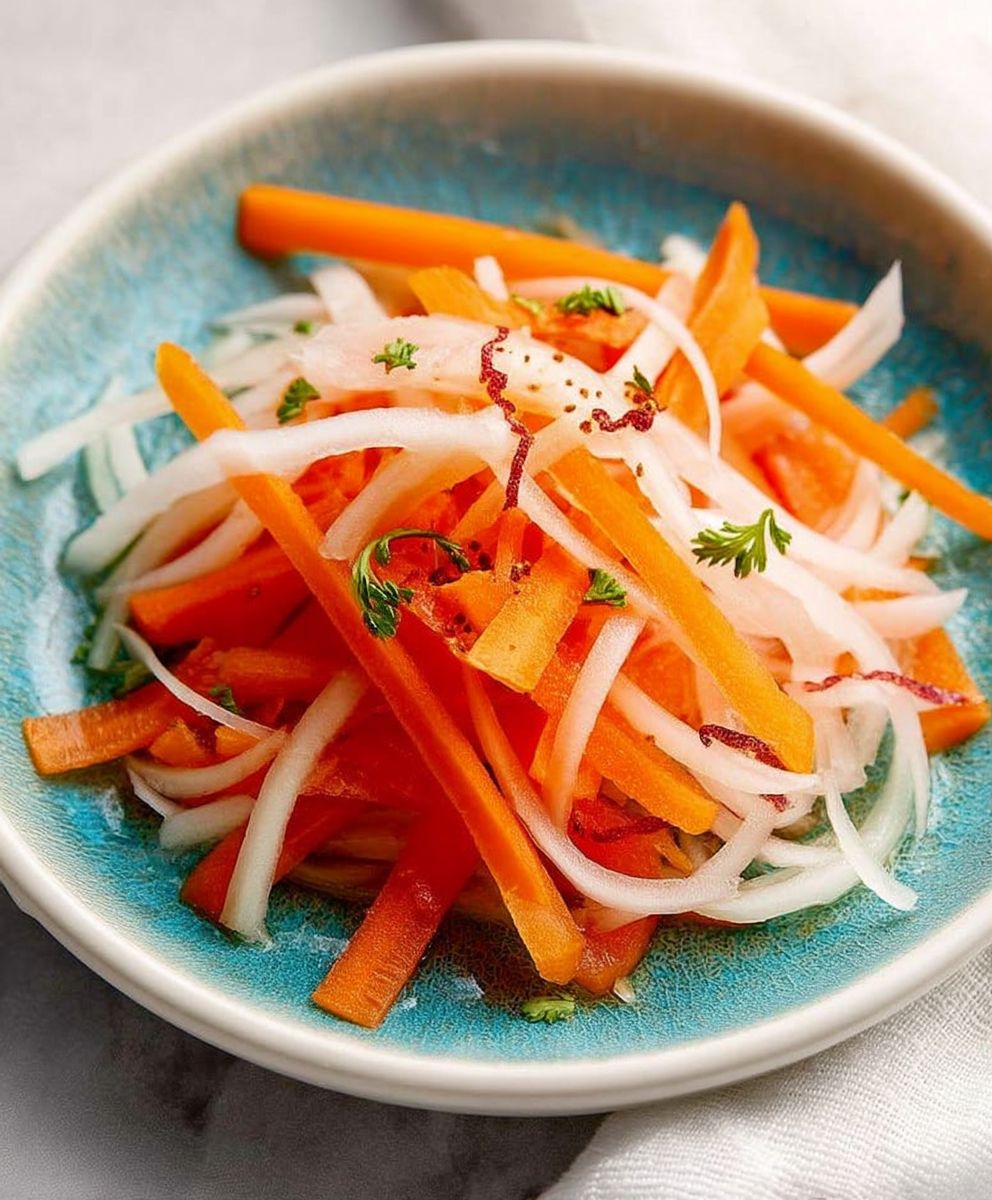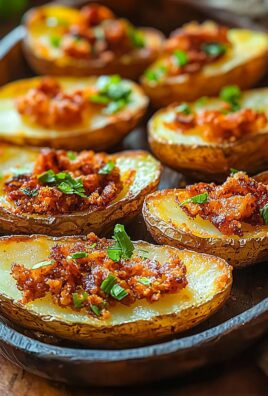Pickled carrots and daikon, or “?? Chua” as it’s lovingly known in Vietnamese cuisine, are more than just a crunchy condiment; they’re a vibrant burst of flavor and a testament to the art of preserving fresh produce. Have you ever wondered how to elevate your banh mi, spring rolls, or even a simple rice bowl to a whole new level of deliciousness? The answer lies in these tangy, slightly sweet, and utterly addictive pickled vegetables.
?? Chua holds a special place in Vietnamese culinary tradition, often prepared during T?t (Vietnamese Lunar New Year) as a symbol of prosperity and good fortune. The crisp texture and bright colors are believed to bring joy and freshness to the new year. But its appeal extends far beyond cultural significance. People adore pickled carrots and daikon because they offer a delightful counterpoint to rich and savory dishes. The acidity cuts through the richness, while the subtle sweetness balances the saltiness, creating a harmonious flavor profile that tantalizes the taste buds.
Beyond the incredible taste, this recipe is incredibly convenient. It’s quick to prepare, keeps well in the refrigerator for weeks, and adds a touch of elegance to any meal. So, are you ready to discover the magic of ?? Chua and transform your everyday dishes into culinary masterpieces? Let’s dive in!
Ingredients:
- 1 pound daikon radish, peeled and cut into matchsticks
- 1 pound carrots, peeled and cut into matchsticks
- 1 cup water
- 1 cup white vinegar
- 1/2 cup granulated sugar
- 1 tablespoon salt
- 2 cloves garlic, minced (optional)
- 1 red chili pepper, thinly sliced (optional, for heat)
Preparing the Vegetables:
- First, let’s get our vegetables ready. Make sure your daikon radish and carrots are peeled. I like to use a vegetable peeler for this. Once peeled, cut them into matchsticks. The size doesn’t have to be perfect, but try to keep them relatively uniform so they pickle evenly. Aim for about 2-3 inches long and 1/4 inch thick. This will give them a nice texture and allow them to absorb the pickling liquid well. If you have a mandoline slicer with a julienne blade, that can speed up the process considerably! Just be careful when using it.
- Place the matchstick carrots and daikon in a large bowl. We’ll be adding the pickling liquid soon, so make sure the bowl is big enough to hold everything comfortably.
Making the Pickling Brine:
- Now, let’s create the pickling brine. In a medium saucepan, combine the water, white vinegar, granulated sugar, and salt. The white vinegar provides the tang, the sugar balances the acidity, and the salt helps to preserve the vegetables and enhance their flavor.
- Place the saucepan over medium heat. Stir the mixture constantly until the sugar and salt are completely dissolved. You don’t want any gritty bits left at the bottom of the pan. This usually takes just a few minutes.
- Once the sugar and salt are dissolved, remove the saucepan from the heat. Let the brine cool slightly for about 5-10 minutes. You don’t want to pour boiling hot liquid over the vegetables, as it can make them too soft. A slightly warm brine is ideal for quick pickling.
- If you’re using garlic and chili pepper, now is the time to add them to the brine. The garlic will infuse the brine with a savory flavor, and the chili pepper will add a touch of heat. Adjust the amount of chili pepper to your liking, depending on how spicy you want the pickled vegetables to be. I usually use one small red chili pepper, thinly sliced, for a mild kick.
Pickling the Vegetables:
- Carefully pour the slightly cooled pickling brine over the carrots and daikon in the bowl. Make sure the vegetables are completely submerged in the liquid. If necessary, you can gently press them down with a spoon or fork to ensure they are fully covered.
- Place a plate or a smaller bowl on top of the vegetables to weigh them down and keep them submerged in the brine. This will help them pickle evenly.
- Let the vegetables sit at room temperature for at least 30 minutes, or up to 1 hour. The longer they sit, the more pickled they will become. I usually find that 30 minutes is enough for a slightly tangy flavor, while 1 hour gives them a more pronounced pickled taste.
- After the vegetables have pickled at room temperature, transfer them to an airtight container. Pour the pickling brine over them as well.
- Refrigerate the pickled carrots and daikon for at least 2 hours before serving. This will allow the flavors to meld together and the vegetables to become even more crisp and tangy. The longer they sit in the refrigerator, the better they will taste.
Serving and Storage:
- The pickled carrots and daikon are now ready to serve! They are a delicious and versatile condiment that can be used in a variety of ways.
- They are a classic addition to banh mi sandwiches, adding a tangy and crunchy element that complements the other ingredients perfectly.
- You can also serve them as a side dish with grilled meats, fish, or tofu. Their acidity helps to cut through the richness of the main course.
- They are also a great addition to salads, adding a burst of flavor and texture.
- I sometimes add them to spring rolls or summer rolls for an extra layer of flavor.
- Store the pickled carrots and daikon in the refrigerator for up to 2 weeks. The pickling brine will help to preserve them and keep them fresh.
- Over time, the vegetables may become softer, but they will still be safe to eat. Just be sure to check for any signs of spoilage, such as mold or an off odor.
Tips and Variations:
- For a sweeter pickle, you can add more sugar to the brine. Start with an extra tablespoon or two and adjust to your liking.
- For a spicier pickle, you can add more chili pepper or use a hotter variety. You can also add a pinch of red pepper flakes to the brine.
- If you don’t have white vinegar, you can use apple cider vinegar or rice vinegar instead. These will give the pickled vegetables a slightly different flavor.
- You can also add other vegetables to the pickle, such as cucumbers, radishes, or bell peppers. Just be sure to cut them into similar sizes as the carrots and daikon.
- For a more complex flavor, you can add spices to the brine, such as star anise, cloves, or peppercorns.
- If you want to make a larger batch of pickled carrots and daikon, simply double or triple the recipe. Just be sure to use a large enough container to hold all of the vegetables and brine.
- Don’t discard the pickling brine after you’ve finished the vegetables! You can use it to pickle other vegetables, such as onions or cucumbers. You can also use it as a marinade for meats or tofu.
- If you find that the pickled vegetables are too sour, you can rinse them with cold water before serving. This will help to remove some of the excess vinegar.
- Experiment with different flavors and ingredients to create your own unique pickled carrots and daikon recipe! The possibilities are endless.
Troubleshooting:
- Vegetables are too soft: This can happen if the brine is too hot when you pour it over the vegetables, or if you pickle them for too long. To prevent this, let the brine cool slightly before pouring it over the vegetables, and check them frequently to see if they are pickled to your liking.
- Vegetables are not sour enough: This can happen if there is not enough vinegar in the brine, or if you don’t pickle them for long enough. To fix this, add more vinegar to the brine, or let the vegetables pickle for a longer period of time.
- Brine is too sweet: This can happen if there is too much sugar in the brine. To fix this, add more vinegar to the brine, or dilute it with water.
- Brine is too salty: This can happen if there is too much salt in the brine. To fix this, dilute the brine with water.
- Pickled vegetables are slimy: This is a sign of spoilage. Discard the pickled vegetables immediately.
Health Benefits:
- Pickled carrots and daikon are a good source of probiotics, which are beneficial bacteria that can help to improve gut health.
- They are also a good source of vitamins and minerals, such as vitamin C, vitamin K, and potassium.
- The vinegar in the pickling brine may help to lower blood sugar levels and improve insulin sensitivity.
- Pickled vegetables are low in calories and fat, making them a healthy addition to your diet.
- The fermentation process can increase the bioavailability of certain nutrients, making them easier for your body to absorb.
Why This Recipe Works:
- The balance of sweet, sour, and salty flavors in the brine is perfectly calibrated to complement the natural sweetness of the carrots and the slightly peppery flavor of the daikon.
- The matchstick cut of the vegetables allows them to pickle quickly and evenly, resulting in a crisp and tangy texture.
- The optional addition of garlic and chili pepper adds depth and complexity to the flavor profile.
- The recipe is easy to follow and requires only a few simple ingredients.
- The pickled carrots and daikon can be stored in the refrigerator for up to 2 weeks, making them a convenient and versatile condiment to have on hand.
Final Thoughts:
- Pickled carrots and daikon are a delicious and versatile condiment that can be enjoyed in a variety of ways. Whether you’re adding them to banh mi sandwiches, serving them as a side dish, or using them as a topping

Conclusion:
This isn’t just another recipe; it’s a passport to a flavor explosion! The vibrant crunch of pickled carrots and daikon, with its perfect balance of sweet, sour, and subtly spicy notes, is truly irresistible. I wholeheartedly believe that this recipe is a must-try for anyone looking to elevate their culinary game and add a touch of zing to their meals. It’s incredibly versatile, surprisingly simple to make, and the results are consistently delicious.
Think of it as your secret weapon for adding brightness and texture to everything from banh mi sandwiches and spring rolls to tacos and salads. Seriously, the possibilities are endless! I’ve even been known to sneak a few spears straight from the jar as a quick and healthy snack.
But the real magic lies in its ability to transform ordinary dishes into something extraordinary. Imagine a simple grilled cheese sandwich elevated with a layer of these tangy vegetables, or a plain bowl of rice noodles brought to life with their vibrant colors and flavors. This pickled carrots and daikon recipe is more than just a condiment; it’s a flavor enhancer that will awaken your taste buds and leave you craving more.
And don’t be afraid to experiment! While the recipe I’ve shared is my go-to, there’s plenty of room for customization. Want a little extra heat? Add a thinly sliced chili pepper to the brine. Prefer a sweeter pickle? Increase the sugar slightly. Feeling adventurous? Try adding a few slices of ginger or garlic for an extra layer of complexity.
Serving suggestions are just as diverse. As I mentioned, it’s fantastic in banh mi, adding that essential crunch and tang. But it’s also incredible as a topping for pulled pork sliders, a side dish with grilled fish, or even mixed into a vibrant slaw. I’ve even used the pickling liquid as a base for a salad dressing, adding a unique and flavorful twist.
For a fun variation, try adding other vegetables to the mix. Thinly sliced cucumbers, red onions, or even bell peppers would all work beautifully. Just be sure to adjust the pickling time accordingly, as some vegetables will soften more quickly than others.
The beauty of this recipe is that it’s incredibly forgiving. Don’t worry about being too precise with your measurements; a little more or less of any ingredient won’t make a huge difference. The most important thing is to have fun and experiment until you find a flavor profile that you absolutely love.
I truly hope you’ll give this recipe a try. I’m confident that you’ll be amazed by how easy it is to make and how much flavor it adds to your meals. And more importantly, I’d love to hear about your experience! Did you try any variations? What dishes did you use it in? What did you think of the flavor?
Please, don’t hesitate to share your thoughts and photos in the comments below. I’m always eager to learn from my readers and see how they’re putting their own spin on my recipes. So go ahead, grab some carrots and daikon, and get pickling! I promise, you won’t regret it. Happy cooking!
Pickled Carrots and Daikon: A Crunchy, Tangy Recipe
Quick and easy pickled carrots and daikon radish, perfect for banh mi sandwiches, salads, or as a tangy side dish.
Ingredients
- 1 pound daikon radish, peeled and cut into matchsticks
- 1 pound carrots, peeled and cut into matchsticks
- 1 cup water
- 1 cup white vinegar
- 1/2 cup granulated sugar
- 1 tablespoon salt
- 2 cloves garlic, minced (optional)
- 1 red chili pepper, thinly sliced (optional, for heat)
Instructions
- Prepare Vegetables: Peel daikon radish and carrots. Cut into matchsticks (approx. 2-3 inches long, 1/4 inch thick). Place in a large bowl.
- Make Pickling Brine: In a medium saucepan, combine water, white vinegar, granulated sugar, and salt.
- Heat over medium heat, stirring constantly until sugar and salt are dissolved.
- Remove from heat and let cool slightly (5-10 minutes).
- If using, add minced garlic and sliced chili pepper to the brine.
- Pickle Vegetables: Pour the slightly cooled brine over the carrots and daikon in the bowl, ensuring they are completely submerged.
- Place a plate or smaller bowl on top to weigh down the vegetables.
- Let sit at room temperature for 30 minutes to 1 hour, depending on desired tanginess.
- Transfer vegetables and brine to an airtight container.
- Refrigerate for at least 2 hours before serving.
Notes
- Serving Suggestions: Serve in banh mi sandwiches, as a side dish with grilled meats, in salads, or in spring rolls.
- Storage: Store in the refrigerator for up to 2 weeks.
- Sweeter Pickle: Add more sugar to the brine (start with 1-2 tablespoons extra).
- Spicier Pickle: Add more chili pepper or red pepper flakes.
- Vinegar Alternatives: Use apple cider vinegar or rice vinegar instead of white vinegar.
- Other Vegetables: Add cucumbers, radishes, or bell peppers.
- Spice Additions: Add star anise, cloves, or peppercorns to the brine.
- Don’t discard the brine! Use it to pickle other vegetables or as a marinade.
- Too Sour? Rinse with cold water before serving.
- Vegetables too soft: Let the brine cool slightly before pouring it over the vegetables, and check them frequently to see if they are pickled to your liking.
- Vegetables are not sour enough: Add more vinegar to the brine, or let the vegetables pickle for a longer period of time.
- Brine is too sweet: Add more vinegar to the brine, or dilute it with water.
- Brine is too salty: Dilute the brine with water.
- Pickled vegetables are slimy: This is a sign of spoilage. Discard the pickled vegetables immediately.






Leave a Comment